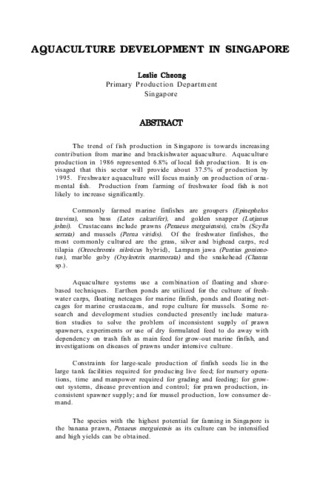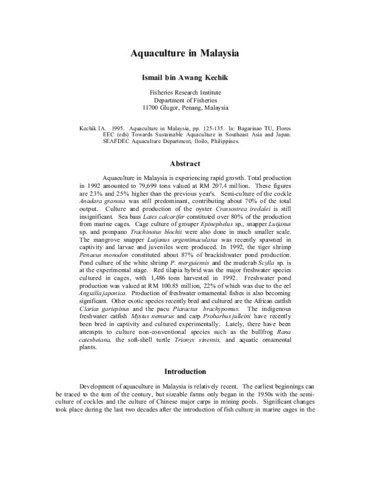Aquaculture development in Singapore
- Global styles
- MLA
- Vancouver
- Elsevier - Harvard
- APA
- Help

Date
1988Author
Page views
6,833ASFA keyword
seed (aquaculture) 
stocking density
crustacean culture
husbandry diseases
pond culture
mussel culture
seed production
prawn culture
crab culture
aquarium culture
brackishwater aquaculture
aquaculture systems
aquaculture development
cage culture
feeding experiments
ornamental fishes
mariculture
freshwater aquaculture
breeding stock
fish culture

stocking density

crustacean culture

husbandry diseases

pond culture

mussel culture

seed production

prawn culture

crab culture

aquarium culture

brackishwater aquaculture

aquaculture systems

aquaculture development

cage culture

feeding experiments

ornamental fishes

mariculture

freshwater aquaculture

breeding stock

fish culture

AGROVOC keyword
Taxonomic term
Metadata
Show full item record
Share
Abstract
The trend of fish production in Singapore is towards increasing contribution from marine and brackishwater aquaculture. Aquaculture production in 1986 represented 6.8% of local fish production. It is envisaged that this sector will provide about 37.5% of production by 1995. Freshwater aquaculture will focus mainly on production of ornamental fish. Production from farming of freshwater food fish is not likely to increase significantly.
Commonly farmed marine finfishes are groupers (Epinephelus tauvina), sea bass (Lates calcarifer), and golden snapper (Lutjanus johni). Crustaceans include prawns (Penaeus merguiensis), crabs (Scylla serrata) and mussels (Perna viridis). Of the freshwater finfishes, the most commonly cultured are the grass, silver and bighead carps, red tilapia (Oreochromis niloticus hybrid), Lampam jawa (Puntius gonionotus), marble goby (Oxyleotrix marmorata) and the snakehead (Channa sp.).
Aquaculture systems use a combination of floating and shorebased techniques. Earthen ponds are utilized for the culture of freshwater carps, floating netcages for marine finfish, ponds and floating netcages for marine crustaceans, and rope culture for mussels. Some research and development studies conducted presently include maturation studies to solve the problem of inconsistent supply of prawn spawners, experiments or use of dry formulated feed to do away with dependency on trash fish as main feed for grow-out marine finfish, and investigations on diseases of prawns under intensive culture.
Constraints for large-scale production of finfish seeds lie in the large tank facilities required for producing live feed; for nursery operations, time and manpower required for grading and feeding; for growout systems, disease prevention and control; for prawn production, inconsistent spawner supply; and for mussel production, low consumer demand.
The species with the highest potential for fanning in Singapore is the banana prawn, Penaeus merguiensis as its culture can be intensified and high yields can be obtained.
Suggested Citation
Cheong, L. (1988). Aquaculture development in Singapore. In J. V. Juario & L. V. Benitez (Eds.), Perspectives in Aquaculture Development in Southeast Asia and Japan: Contributions of the SEAFDEC Aquaculture Department. Proceedings of the Seminar on Aquaculture Development in Southeast Asia, 8-12 September 1987, Iloilo City, Philippines. (pp. 117-128). Tigbauan, Iloilo, Philippines: SEAFDEC, Aquaculture Department.
Type
Conference paperISBN
971851113XCollections
- ADSEA '87 [20]
Related items
Showing items related by title, author, creator and subject.
-
Aquaculture in Malaysia
Kechik, Ismail bin Awang. (Aquaculture Department, Southeast Asian Fisheries Development Center, 1995)Aquaculture in Malaysia is experiencing rapid growth. Total production in 1992 amounted to 79,699 tons valued at RM 207.4 million. These figures are 23% and 25% higher than the previous year's. Semi-culture of the cockle ... -
Aquaculture development in Thailand
Sirikul, Boonsong; Luanprida, Somsak; Chaiyakam, Kanit; Sriprasert, Revadee (Aquaculture Department, Southeast Asian Fisheries Development Center, 1988)Aquaculture practised in Thailand is in the form of pond culture and cage culture in freshwater, brackishwater and coastal areas. The main species cultured include freshwater prawns, brackishwater shrimp, cockles, mussels, ... -
The Philippine aquaculture industry
Camacho, Arsenio S.; Macalincag-Lagua, Natividad (Aquaculture Department, Southeast Asian Fisheries Development Center, 1988)The aquaculture sector of the Philippine fishing industry registered the highest growth rate of 12.5% in 1977-1986. The contribution of aquaculture to the total fish production was equivalent to 24% in 1986 compared to ...





